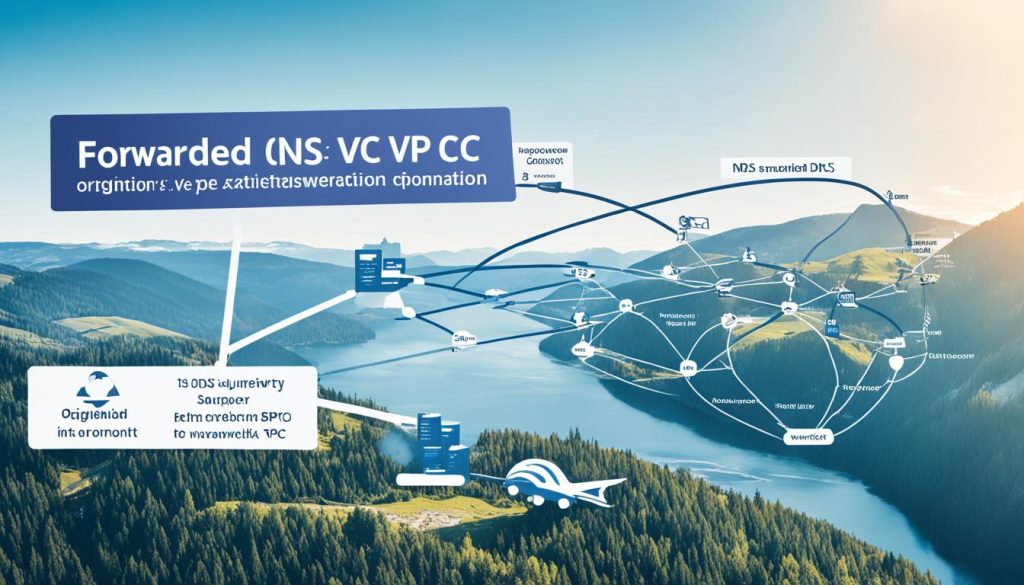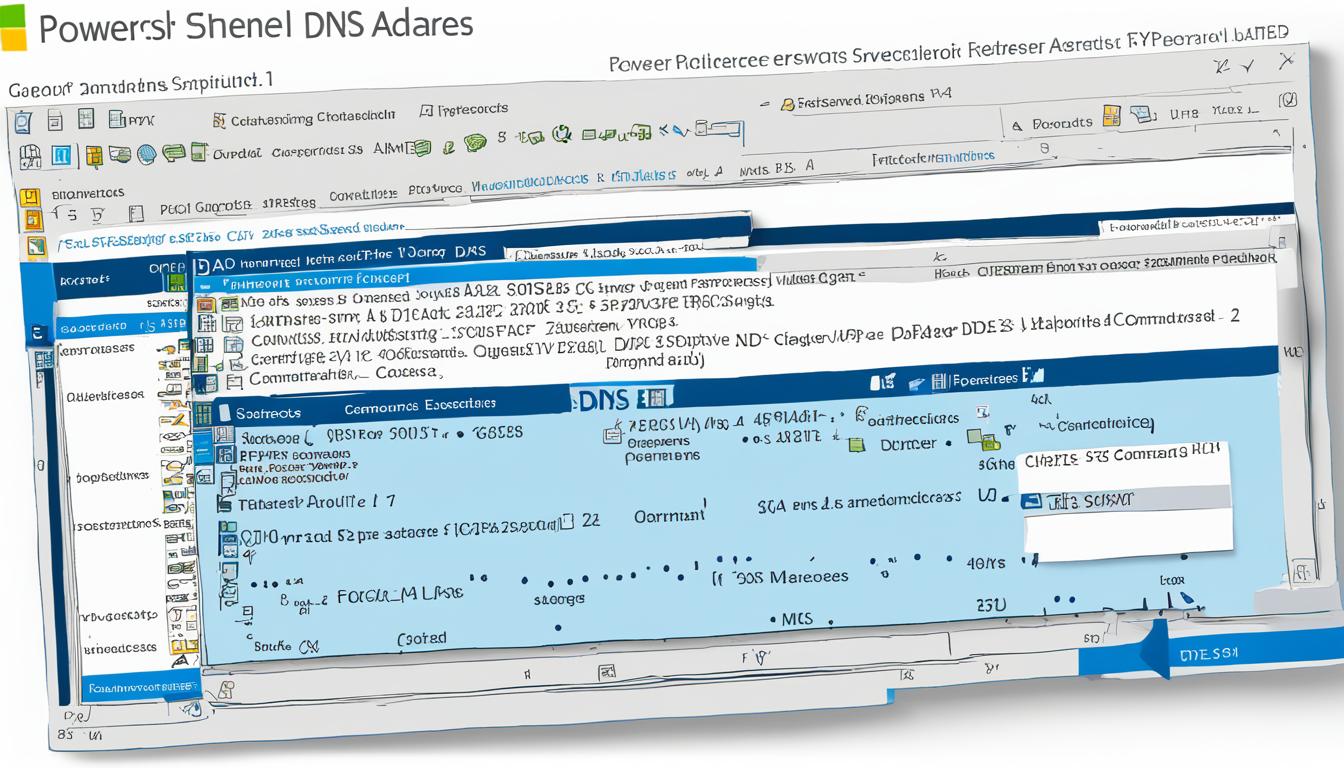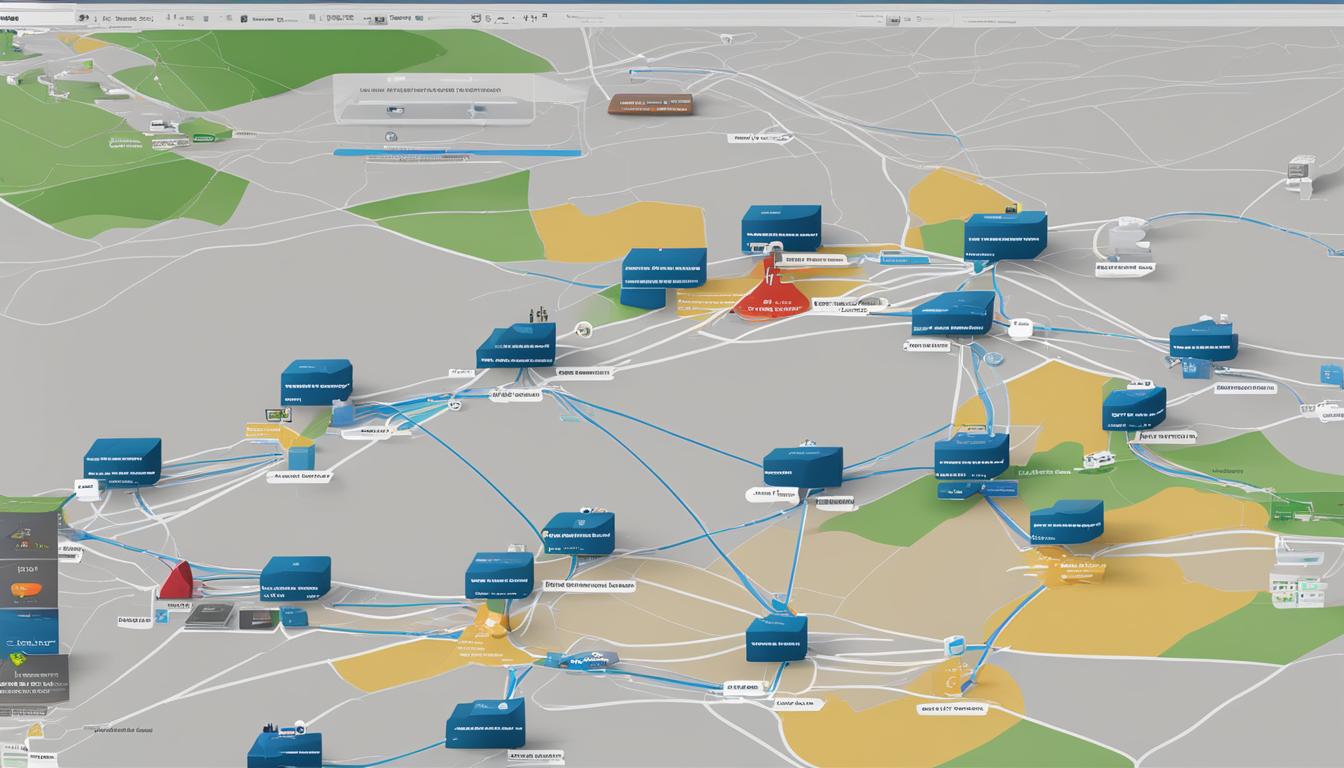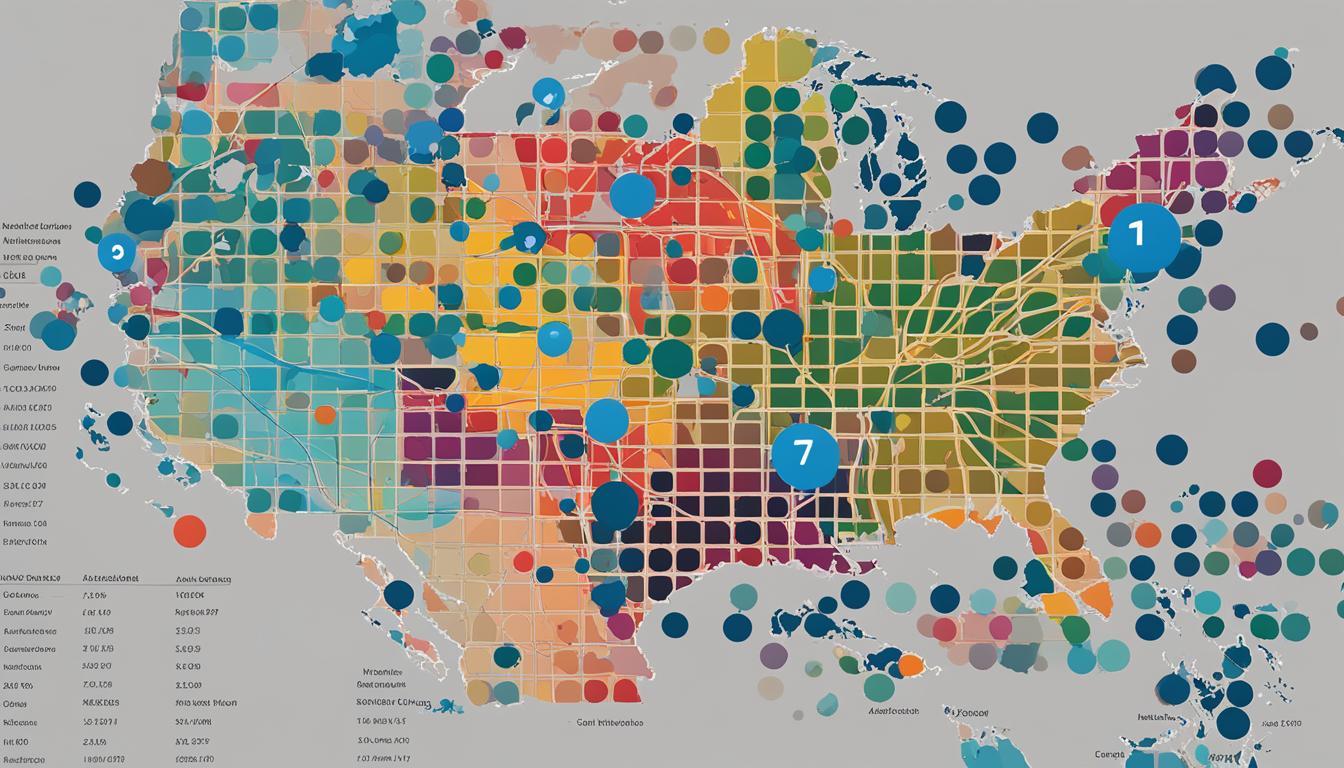Resolving DNS queries between VPCs and your network
Did you know that DNS resolution plays a crucial role in connecting your Virtual Private Clouds (VPCs) with your network? It’s a vital component that ensures seamless communication and efficient data transfer.
In today’s digitally connected world, where organizations rely on cloud infrastructure and inter-VPC communication, having a robust DNS resolution mechanism is essential. Whether you need to resolve DNS queries within your VPCs or bridge the gap between your VPCs and your network, Route 53 Resolver is here to help.
Key Takeaways:
- Route 53 Resolver enables DNS resolution between VPCs and your network.
- Resolver endpoints facilitate the forwarding of DNS queries to and from your on-premises environment.
- You can configure Resolver rules to control which queries are forwarded to your network.
- Route 53 Resolver is designed to respond to DNS queries for public records, VPC-specific DNS names, and private hosted zones.
- Testing the configuration of Resolver endpoints can be done using the “dig” command (for Linux/macOS) or the “nslookup” command (for Windows).
How DNS resolvers on your network forward DNS queries to Route 53 Resolver endpoints
To ensure smooth DNS resolution between your network and Route 53 Resolver endpoints, you need to follow a straightforward process. First, create a Route 53 Resolver inbound endpoint in a Virtual Private Cloud (VPC) and specify the IP addresses that your network’s resolvers will forward queries to.
When creating the inbound endpoint, Resolver automatically generates a VPC elastic network interface for each specified IP address. This interface acts as a bridge between your network and the Resolver.
Once your inbound endpoint is set up, configure your network’s resolvers to forward DNS queries for the relevant domain names to the IP addresses specified in the inbound endpoint. This configuration enables Resolver to resolve the queries and return the values to your network’s resolvers, which in turn deliver the values back to the application.
By establishing this seamless connectivity between DNS resolvers on your network and Route 53 Resolver endpoints, you ensure efficient and reliable DNS resolution for your applications and services.
How Route 53 Resolver endpoint forwards DNS queries from your VPCs to your network
To forward DNS queries from EC2 instances in your VPCs to your network, you need to create a Route 53 Resolver outbound endpoint in a VPC. This endpoint acts as a bridge between your VPC and network, allowing seamless communication.
First, specify the VPC through which you want the DNS queries to pass. This ensures that the queries from your EC2 instances are directed to the outbound endpoint.
Next, specify the IP addresses in the VPC from which the Resolver should forward the queries. These IP addresses serve as the starting point for the DNS resolution process.
Additionally, you’ll need to define a VPC security group to control the inbound and outbound traffic for the Resolver endpoint. This ensures the security and integrity of the DNS queries being forwarded.
Route 53 Resolver automatically creates VPC elastic network interfaces for each specified IP address, enabling efficient routing of the DNS queries.
To complete the configuration, you need to create Resolver rules. These rules specify the domain names of the DNS queries to be forwarded and the IP addresses of the resolvers on your network to which the queries should be sent.
Each rule is associated with the VPCs for which you want to forward DNS queries to your network. This allows for targeted and selective forwarding based on your specific requirements.

By setting up the Route 53 Resolver outbound endpoint and configuring the necessary rules, you can seamlessly forward DNS queries from your VPCs to your network, ensuring efficient and reliable communication across your infrastructure.
Using rules to control which queries are forwarded to your network
You have the ability to create rules that allow you to control which DNS queries are forwarded from Resolver to the DNS resolvers on your network. Resolver automatically generates autodefined rules specifically for AWS domain names, ensuring seamless connectivity. Additionally, you can create custom forwarding rules to further customize your DNS query resolution.
Custom rules offer the flexibility to be either conditional forwarding rules or system rules depending on your requirements. Conditional forwarding rules enable you to selectively forward queries for specific domain names, allowing for granular control over DNS resolution. On the other hand, system rules have the capability to selectively override the behavior defined in a forwarding rule, ensuring efficient and reliable DNS resolution.
By categorizing these rules based on who creates them (autodefined or custom) and what they do (conditional forwarding or system rules), you can effectively manage and control the flow of queries between Resolver and your DNS resolvers on the network.

For a better understanding of the rules in action, let’s take a closer look at an example:
| Rule Type | Function |
|---|---|
| Conditional Forwarding Rule | Forward DNS queries for example.com to a specific DNS resolver on your network. |
| System Rule | Override a forwarding rule to prioritize a secondary DNS resolver when resolving queries for a critical application. |
This table illustrates the practical application of rules to control DNS query forwarding. With conditional forwarding rules, you can ensure that queries for a specific domain name, such as example.com, are directed to a designated DNS resolver on your network. Meanwhile, system rules provide the flexibility to modify the behavior defined in a forwarding rule, enabling you to prioritize secondary DNS resolvers for critical applications.
Resolving DNS queries between VPCs and your network
When it comes to resolving DNS queries between your VPCs and your network, Route 53 Resolver offers a reliable and efficient solution. Whether you need to handle queries for AWS resources, VPC-specific DNS names, or private hosted zones, Route 53 Resolver has got you covered.
Route 53 Resolver automatically responds to DNS queries for local VPC domain names and records in private hosted zones. For public domain names, it performs recursive lookups against public name servers, ensuring accurate resolution every time.
To establish seamless connectivity between your on-premises resources and VPCs, you can leverage Resolver endpoints and conditional forwarding rules. Inbound endpoints allow DNS queries from your on-premises network or another VPC to reach your VPC, while outbound endpoints facilitate DNS queries from your VPC to your on-premises network or another VPC.
The power of Resolver extends further with the ability to create custom forwarding rules. These rules enable you to specify domain names and DNS resolvers on your network, providing granular control over DNS query resolution. With Resolver rules, you can tailor the forwarding process to meet the needs of your specific network architecture.
Resolving DNS queries between VPCs and your network has never been easier with Route 53 Resolver. Its intuitive features and robust capabilities ensure that your DNS infrastructure operates seamlessly, enabling smooth communication between your VPCs and your network.
| Feature | Benefits |
|---|---|
| Automated DNS query resolution for local VPC domain names and private hosted zones | Efficient and accurate resolution of internal resources |
| Recursive lookups against public name servers for public domain names | Reliable resolution of public resources |
| Inbound endpoints for DNS queries from your on-premises network or another VPC | Seamless connectivity between your on-premises resources and VPCs |
| Outbound endpoints for DNS queries from your VPC to your on-premises network or another VPC | Effortless resolution of queries originating from your VPC |
| Custom forwarding rules for granular control over DNS query resolution | Flexibility in shaping the DNS forwarding process |
How to configure Amazon Route 53 Resolver outbound endpoint to resolve DNS records
To configure an outbound endpoint in Amazon Route 53 Resolver for resolving DNS records on a remote network from resources in a Virtual Private Cloud (VPC), you need to follow a few steps:
- Ensure that DNS resolution is enabled for the VPC associated with the Resolver rule. You can do this by checking the DNS support attributes for the VPC and ensuring that DNS resolution is turned on.
- Configure the outbound endpoint by specifying the necessary general settings. This includes specifying a security group that allows outbound connectivity to the IP addresses and ports used by the remote DNS resolvers. Make sure to provide the IP addresses of the DNS resolvers on your remote network and the ports they use. These settings are crucial for establishing connectivity and enabling the resolution of DNS records.
- Associate the outbound endpoint with the VPC from which the DNS queries will originate. This ensures that the Resolver forwards the queries from the VPC to the remote network for resolution.
This configuration enables you to resolve DNS records on a remote network, allowing your VPC resources to connect and communicate with the appropriate endpoints beyond your VPC boundaries.
| Steps to Configure Route 53 Resolver Outbound Endpoint |
|---|
| Step 1: Enable DNS resolution for the VPC |
| Step 2: Configure the outbound endpoint |
| Step 3: Associate the outbound endpoint with the VPC |
By following these steps, you can seamlessly configure the outbound endpoint in Amazon Route 53 Resolver and ensure the successful resolution of DNS records across your network.
How to create a Resolver rule to forward DNS queries to remote network
Creating a Resolver rule is a straightforward process that allows you to forward DNS queries from your VPC to a remote network. Follow the steps below to create a Resolver rule:
- Create a new rule or use an existing one: Depending on your requirements, you can create a new Resolver rule or use an existing one. If you choose to create a new rule, make sure to specify the rule type as “Forward”.
- Associate the rule with the VPC: When creating a new rule, associate it with the VPC from where the DNS queries will be forwarded. This ensures that the rule is applied to the correct VPC.
- Specify the IP addresses of the remote DNS resolvers: In the Resolver rule configuration, provide the IP addresses of the DNS resolvers on your remote network to which the queries should be forwarded.
- Configure the ports used by the DNS resolvers: Additionally, specify the ports used by the remote DNS resolvers. This ensures that the Resolver can communicate with the resolvers on the remote network effectively.
If you already have an existing Resolver rule for the same domain in the same Region as the VPC, you can associate that rule with the VPC instead of creating a new one. However, if the existing rule is in a different account, you can use AWS Resource Access Manager to share the rule and the corresponding outbound endpoint with your account.
Creating a Resolver rule is a crucial step in establishing the connection between your VPC and a remote network, allowing for seamless DNS query forwarding. It enables efficient communication and integration between different network environments.
By following the steps outlined above, you can easily configure a Resolver rule to forward DNS queries to a remote network, facilitating efficient communication and seamless connectivity between your VPC and the remote network.
How to test the configuration of Route 53 Resolver endpoints
Testing the configuration of Route 53 Resolver endpoints is an essential step to ensure the smooth functioning of your DNS resolution setup. To carry out this test, you can perform a DNS resolution from one of the Amazon EC2 instances in your VPC. This will allow you to validate that the DNS queries are being resolved correctly by the Resolver and reaching the remote network as intended.
If you are using Linux or macOS, you can utilize the “dig” command to perform the DNS resolution test. Simply execute the command with the specific record names and types you want to query. For Windows users, the equivalent command is “nslookup”. By running these commands, you can verify that the DNS queries are being successfully resolved by the Resolver and reaching the desired remote network.
Through conducting these tests, you can gain confidence in the configuration of your Route 53 Resolver endpoints. It enables you to identify any potential issues or misconfigurations early on and take appropriate corrective measures. By ensuring the proper functioning of your Resolver endpoints, you can establish reliable DNS query resolution between your VPCs and your network, facilitating seamless communication and connectivity for your applications and services.
FAQ
How can I resolve DNS queries between VPCs and my network?
How do DNS resolvers on my network forward DNS queries to Route 53 Resolver endpoints?
How does Route 53 Resolver endpoint forward DNS queries from my VPCs to my network?
How can I control which DNS queries are forwarded to my network?
How can I configure an Amazon Route 53 Resolver outbound endpoint to resolve DNS records?
How can I create a Resolver rule to forward DNS queries to a remote network?
How can I test the configuration of Route 53 Resolver endpoints?
- How Strategic SEO Drove Growth for a CPAP E-commerce Brand - July 24, 2025
- Top 3 SEO Companies in Toronto: An Analytical Comparison - July 23, 2025
- SEO for Entry Door Services - April 24, 2025





















Post Comment
You must be logged in to post a comment.